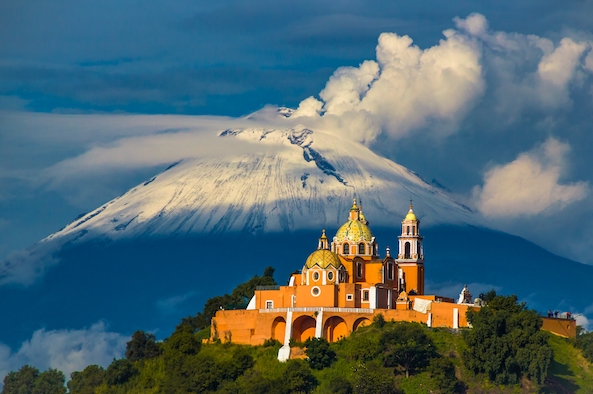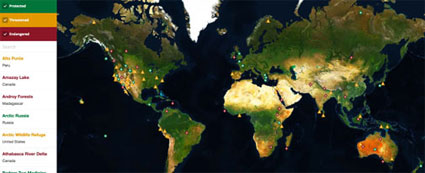
Cholula
| Status | Protected |
| Country | Mexico |
| Report By | Neeka Salmasi |
| Thanks | Rich Briggs for the copyrighted photo. |
| Posted | June 3, 2020 |

In Cholula, Mexico, stands the largest pyramid ever built in human history. This ancient temple could easily be mistaken for a church-on-a-hill scene, as its body is now buried in greenery, and a Catholic church sits on its top. A once vibrant Mesoamerican town at the pyramid’s base was dedicated to the god Quetzalcoóatl before the arrival of the Spanish. After their violent conquest, resulting in the massacre of nearly ten percent of Cholula’s population, the Spanish built a church—not only on top of this monument, but on every native temple in the area. Cholula was designated a UNESCO World Heritage Site in 1987.
The Land and Its People
The Great Pyramid of Cholula: Tlachihualtepetl, or “handmade mountain” in Nahuatl (the Aztec language of Central Mexico), is located in the ancient city of Cholula, which was originally constructed as a holy city. Cholula means “Place of Refuge” in Nahuatl. Before the Spanish conquest in the 16th century, Cholula was one of the largest cities and principal religious centers in Mexico, with a multiethnic population of between 60,000 and 100,000. Standing 180 feet above the surrounding plain, the pyramid was almost twice the volume of the Great Pyramid of Giza and a base four times larger. Construction of Tlaxhihualtepetl began around 300 BC. Successive civilizations added to what had already been built, eventually resulting in the giant pyramid-disguised-as-a-hill that exists today. This temple was constructed to honor Quetzalcóatl, the feathered Mesoamerican serpent god. Other accounts, such as that of the sixteenth century Spanish administrator of Cholula, mention a pagan shrine on top of the Great Pyramid that was dedicated to Chiconauquiahuitl—the goddess of the nine rains.
In 1519, Hernan Cortés arrived in Cholula with his army of conquistadors and Tlazcaltecan allies. Some argue that Cortés’s Tlazcaltecan allies encouraged the conquistadors to continue their conquest by way of Cholula. Others claim that it was Malintzin, a female slave turned interpreter, advisor, consort and intermediary to Cortés, who encouraged the route. Other accounts argue that Cortés was eager to see this rumored city for himself. Events leading up to the conquest are also contested: at least 12 different authors wrote or painted diverse first-hand accounts of the ensuing massacre that occurred in Cholula. The result of these events though, was undisputed. Spanish conquistadors assembled Cholula’s noblemen, rulers, captains, chiefs, and other townsmen in the courtyard of the gods, and attacked the mostly unarmed crowd. Legend had it that large floods would devastate anyone who tried to attack the sacred temple, but no such thing occurred. Thousands of Cholulans died that day (Cortes said 3,000, another observer said 30,000). The Cholula Massacre conveyed a powerful message to the mighty leader of the Aztec Empire, Montezuma II, who was waiting nervously for the conquistadores to arrive in the Mexican capital of Tenochtitlan. Oracles and visions had warned Moctezuma that the Spanish were destined to overthrow his kingdom—and these premonitions eventually came true.
In 1574, long after Moctezuma had been killed and Mexico overpowered by the Spanish, a church was built on the top of Tlachihualtepetl. The church was named Iglesia de Nuestra Señora de los Remedios, or Our Lady of the Remedies. Many historians write that Cortés never knew this ‘hill’ was actually a sacred place. This seems unlikely, as it was customary for the Spanish to Christianize and repurpose indigenous sacred places.
Cholula is now considered a UNESCO World Heritage Site. Both the church and ancient ruins beneath it are open to tourists year-round. The site attracts 220,000 visitors annually. Archaeological digs have been conducted around the area, uncovering 650 skeletons, including massacre victims, on the pyramid. In a series of digs within the pyramid over the years, archaeologists have uncovered 400 burials, containing flutes, bone carvings (including a ceremonial scepter), clay figurines of naked women with elaborate hairstyles, a jaguar altar, a mausoleum, a “pyramid of the painted skulls” dating from 200–350 AD, and more.
Perceptive observers note the relationship of the Cholula pyramid temple to two massive volcanoes to the north—Popocatépetl and Iztaccíhuatl. The most popular legend about Iztaccíhuatl and Popocatépetl comes from ancient Nahuas’ oral tradition. There are many versions of the story, along with poems and songs, but basically it goes like this:
Many years before conquistador Hernán Cortés came to Mexico, the Aztecs lived in Tenochtitlan, today’s Mexico City. The chief of the Aztecs was a famous emperor, who was loved by all the natives. The emperor and his wife, the empress, were worried because they had no children. One day the empress said to the emperor that she was going to give birth to a child. A baby girl was born and she was as beautiful as her mother. They called her Iztaccíhuatl, which in Náhuatl means “white lady.” All the natives loved Izta, and her parents prepared her to be the empress of the Aztecs. When she grew up, she fell in love with a captain of a tribe. His name was Popoca. One day, a war broke out and the Aztec warriors went south to fight the enemy. The emperor told Popoca that he had to bring the head of the enemy chief back from the war, so he could marry his daughter. After several months of combat, a warrior who hated Popoca and craved Izta sent a false message to the emperor. The message said that his army had won the war, but that Popoca had died in battle. The emperor was saddened when he heard the news, and when Izta heard she could not stop crying. She refused to go out and did not eat anymore. A few days later, she became ill and died of sadness. When the emperor was preparing Izta’s funeral, Popoca and his warriors arrived victorious from war. The emperor was taken aback when he saw Popoca, and told him that other warriors had announced his death. Then, he told him that Izta had died. Popoca was distraught. He took Izta’s body and left the town. He walked a long way until he arrived at a mountain range where he ordered his warriors to build a funeral table with flowers. He placed Izta’s body on top. Then he knelt down to watch over Izta and then he too died of sadness. The gods were touched by Popoca’s sacrifice and turned the tables and the bodies into great volcanoes. The biggest volcano is Popocatépetl, which in Náhuatl means “smoking mountain.” He sometimes throws out smoke, showing that he is still watching over Iztaccíhuatl, who sleeps by his side.
Find Out More
Cal State LA. “Massacre at Cholula”
Boyd, M. Erwin, J. Hendrickson, M. “The Cholula Massacre: Factional Histories and Archaeology of the Spanish Conquest in the Entangled Past: Integrating History and Archaeology” University of Calgary, Calgary, AB, 2000.
Savanah Nicole Burns, “Hernán Cortés: Cholula’s Massacre at Pyramid of Quetzalcoatl,” Historical Mexico.
McCafferty, G. “The Cholula Massacre: Factional Histories and Archeology of the Spanish Conquest,” University of Calgary.
American Historical Association. “Mexica Account of the Cholula Massacre.”
ThoughtCo., “The Cholula Massacre.”
Continue Exploring Sacred Sites
 Explore a world of sacred lands and discover more than 100 site reports using our interactive map.
Explore a world of sacred lands and discover more than 100 site reports using our interactive map.